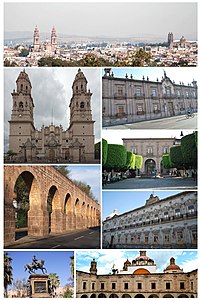
Photo from wikipedia
Four different rocks have been used in the architectural heritage of Morelia city (Michoacán state, México). Piedra Vieja (PV) is the original building rock whilst Tlalpujahua, Cointzio and Jabalina stones… Click to show full abstract
Four different rocks have been used in the architectural heritage of Morelia city (Michoacán state, México). Piedra Vieja (PV) is the original building rock whilst Tlalpujahua, Cointzio and Jabalina stones (TL, CO and JA, respectively) are the replacement varieties used in the restoration works during the last decades. All of them correspond to rhyolitic ignimbrites quarried close to Morelia. The new varieties were selected exclusively after aesthetical similarity, and no petrophysical criterion was considered. In this paper, a deep analysis of the weathering process of these rocks during wet–dry and salt crystallization cycles is carried out. Rock decay is defined in terms of linearity and homogeneity: JA and TL show nonlinear decay mode and heterogeneous behaviours, whilst samples of CO and PV weather after linear and homogeneous modes. Moreover, each rock variety shows different decay patterns, such as differential erosion (PV and TL), fractures (TL), scaling (JA) and granular disintegration (CO). All these obtained results are discussed according to: (1) petrographic factors; (2) hydric and mechanical properties; and (3) the partial effective pressures reached inside the porous system of each rock during salt crystallization. Finally, a review about the quality of previously published durability estimators is carried out. In general terms, results reveal that theoretical estimators best fit the visual weathering suffered by the rocks than its mass loss. Concluding this paper, a petrophysical and aesthetical evaluation of the compatibility between both original and replacement building stones used in the architectural heritage of Morelia is carried out in order to offer technical recommendations for future restoration works. CO ignimbrite offers the highest chromatic compatibility with the original building rock (PV), but its durability is extraordinarily low and consequently its use is not recommended. JA and TL are advisable replacement stones, although from a petrophysical point of view, TL results the most convenient. These results highlight the importance of carrying out the selection of building stones for restoration works according to petrophysical criteria, instead of using exclusively an aesthetic valuation.
Journal Title: Environmental Earth Sciences
Year Published: 2018
Link to full text (if available)
Share on Social Media: Sign Up to like & get
recommendations!